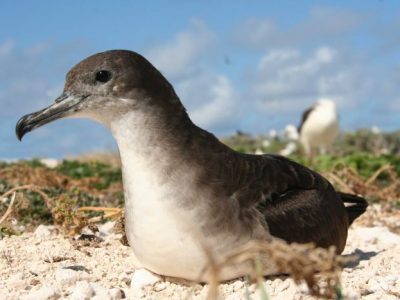COASTAL CULTURAL MODELS – ECOLOGICAL PERSPECTIVE

The ecological health of beaches is important for wildlife too (pc: abc.net.au)
If there is one perspective that can stir debate it is that generated by those who seek to impose an ecological perspective on others. This may not always be the case. However, for those who see the primacy of natural ecological functions as requiring priority in decision making there can be little room for compromise in coastal management. No wonder conflicts can erupt!
Thompson characterises the ecological perspective as involving ecosystem function and ecological connectivity (Coastal Management, 2007, p. 224). He sees it as the least widely shared of his seven cultural models. The issue is one of obligations on individuals, communities and even future generations to adopt in essence the land ethic as proclaimed by the great American conservationist, Aldo Leopold. He argued that we must take seriously our responsibility to the larger biotic community as the individual is a member of a community of interdependent parts including soils, waters, plants and animals, what he sees as collectively “the land”. His view is captured by what some see as a golden rule:
“A thing is right when it tends to preserve the integrity, stability, and beauty of the biotic community. It is wrong when it tends otherwise”.
Stocker and Kennedy (Coastal Management, 2009) in commenting on Thompson’s cultural models, note that some features of an ecological perspective include a tolerance of the natural cycles of change along the coast as well as an appreciation of a diversity of landforms, species and ecosystems (p.393). Much effort in coastal science over decades has been devoted to improving our understanding of such components of coastal domains in different parts of the world. In fact we can trace this scientific heritage back to von Humboldt and Darwin and perhaps earlier. Those like me who have dabbled in biogeomorphology are only too aware of the complexities of the interaction of biophysical processes and how coastal lands in the sense of Leopold are dynamic. Of interest is that the new NSW Coastal Management Act 2016 includes terms like dynamic, ambulatory, impacts of extreme storm events, biological diversity, and ecosystem integrity and resilience in the objects of the Act. These terms were inserted in order to make clear that ecological issues are very relevant to coastal management especially given the overriding object of the Act is to manage the coastal environment of NSW “in a manner consistent with the principles of ecologically sustainable development”.
There are many problems in implementing the ecological model in coastal areas where there is human settlement. There are concerns that few people value natural ecosystems or really understand the significance of biological processes that ensure ecosystem health. Debate amongst so-called experts may not always help as noted by Stocker and Kennedy. But the importance of communicating natural system values can never be underestimated. This can even be reflected in market values; Karl Nordstrom has noted that it is often ironic that while the benefits of nature are used to market coastal real estate, few environmental values survive the development process.
One point made by Thompson sadly resonates with me. He writes about “generational environmental amnesia” (p.225). Environmental degradation along the coast can take many forms including the introduction of exotic plants, or the removal of natural landforms, or changes to water quality . Yet successive generations may have no conception of what pre-degradation conditions looked like so that as the community memory fades there is a decline in standards and expectations. This may result in there being little interest in promoting ecological restoration; active opposition may arise towards those who see long term value in building coastal biotic communities that reflect past natural conditions. People now living on the coast may have difficulty in comprehending what natural conditions might look like especially after others have advocated and have experienced the transformed coastal land full of plants from other countries, fewer birds and wide open views where native shrubs once proliferated.
In recent years there have been concerted efforts at local, state and national levels to promote the restoration of native ecosystems along the Australian coast. Dunecare, Coastcare, Caring for Country have all been federally funded. Groups such as we see working on Fraser Island have done outstanding jobs in educating the public on ecological values. One of my favourite stories is the history of dune restoration at Avalon Beach on the northern beaches of Sydney. A sand blown, weedy mess has been changed and now locally cherished for its ecological values. I greatly admire the recent work of Sydney Ports in restoring the coastal vegetation associated with the construction of the new port extension; one can only hope that the area will be appropriately maintained. Then there are those who fight for the biological integrity of natural waterways that are potentially subject to pollution from developments in catchments.
No doubt the ecological perspective can find itself in conflict with other perspectives/models discussed by Thompson and Stocker and Kennedy. Forces of degradation will continue to place pressure on what remains of natural systems in settled areas. But there are opportunities for communities to protect, maintain and improve those systems; they cannot just be confined to national parks! The new legislation in NSW should make it that little harder to destroy, while there needs to be incentives to retain and improve. Community education becomes a vital component of any future roll out of the ecological perspective recognising that with population growth and urban/periurban expansion more and more natural systems will be under pressure.
Words by Prof Bruce Thom. Please respect Bruce Thom’s thoughts and reference where appropriately: (c) ACS, 2016, posted 5th October 2016, for correspondence about this blog post please email admin@australiancoastalsociety.org


 COASTAL CULTURAL MODELS – LANDSCAPE PERSPECTIVE
COASTAL CULTURAL MODELS – LANDSCAPE PERSPECTIVE